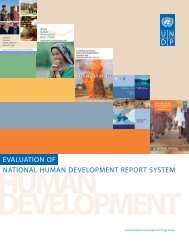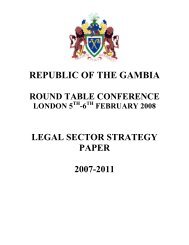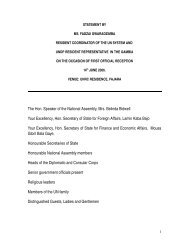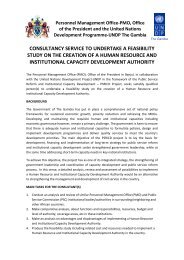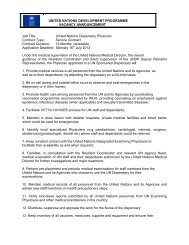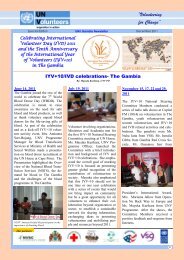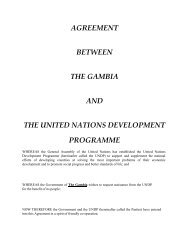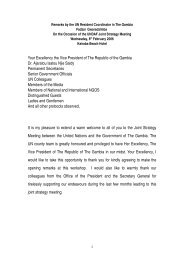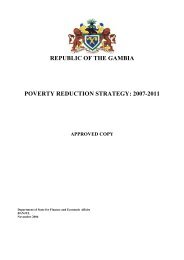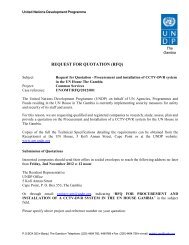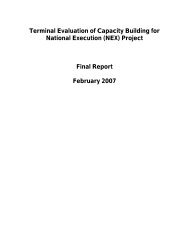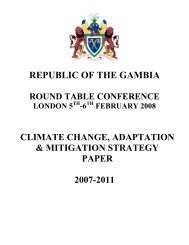Introduction - UNDP The Gambia
Introduction - UNDP The Gambia
Introduction - UNDP The Gambia
You also want an ePaper? Increase the reach of your titles
YUMPU automatically turns print PDFs into web optimized ePapers that Google loves.
________________________________________________________________________________________________________________________<br />
<strong>The</strong> growth and development of the<br />
manufacturing and processing sector is also<br />
handicapped by the limited nature of the<br />
domestic market, shortage of skills and<br />
trained professionals, restricted and<br />
competitive foreign markets for locally<br />
produced goods and weak support structures<br />
for the development of a manufacturing and<br />
processing sector. Figure 2 shows the<br />
breakdown of private sector activity by<br />
industry ( from Situation Analysis of the<br />
Contribution of the Private Sector Towards<br />
the Millennium Development Goals in <strong>The</strong><br />
<strong>Gambia</strong>, 2005)<br />
This concentration of private sector<br />
enterprises has the further pull-effect of the<br />
population from the rural areas, thus<br />
contributing to the depletion of the rural<br />
population and accentuating rural-urban<br />
migration and rural poverty. This is because<br />
people are forced to move to areas where they<br />
can get jobs. Since the major private sector<br />
enterprises, which are major employers, are<br />
not located in the rural areas, able-bodied<br />
people in these areas are forced to migrate to<br />
the urban centres where jobs, goods and<br />
services are more readily available than in the<br />
rural settings.<br />
Figure 2: Breakdown of the Private Sector by<br />
Industry<br />
Although the private sector is supposed to be<br />
the engine of growth, its development is<br />
currently retarded by three major factors:<br />
• low investment resulting from high-risk<br />
perception<br />
• poor legal environment and regulatory<br />
framework with poor economic<br />
governance<br />
• weak financial services.<br />
Low Investment as a Result of High-risk<br />
Perception: <strong>The</strong> level of risk perception is a<br />
major determinant of investment in a<br />
country. In <strong>The</strong> <strong>Gambia</strong>, two risk factors are<br />
of concern to potential investors: political<br />
risks and economic risks. <strong>The</strong> political risk<br />
relates to political uncertainty in the country<br />
and to developments in the sub-region – the<br />
effects of protracted wars and civil unrest in<br />
neighbouring countries. <strong>The</strong> expropriation in<br />
1999 of the <strong>Gambia</strong> Groundnut Corporation<br />
(GGC), a groundnut processing company, has<br />
lingered as a source of potential concern to<br />
investors.<br />
Economic risks are associated with factors<br />
such as chronic balance of payments deficit<br />
that make foreign exchange scarce, high<br />
public indebtedness and governance issues<br />
such as a weak judicial and slow resolution of<br />
commercial disputes and lack of transparent<br />
“rules of the game” exacerbated by the<br />
problems and delays associated with<br />
administrative “red-tape”. Risk ratings by two<br />
well-known international rating services help<br />
to gauge the country’s standing in terms of<br />
investors’ perceptions.<br />
<strong>The</strong> rural areas are experiencing increases in<br />
poverty due to unemployment, lack of<br />
opportunities for income generation and lack<br />
of purchasing power for goods and services.<br />
Sadly, the concentration and development of<br />
the private sector in the urban areas run<br />
counter to the efforts towards achieving the<br />
goals of the MDGs on poverty reduction.<br />
According to the WDI 2002 Euromoney and<br />
the International Country Risk Guide, the<br />
creditworthiness ratings for <strong>The</strong> <strong>Gambia</strong> in<br />
2001 are reported at a level of 27 and 69<br />
respectively. <strong>The</strong>se ratings rank the risk of<br />
investing in an economy in a range of 1<br />
(high) to 100 (low) to create opportunities for<br />
long-term investments. Similarly, Fitch<br />
ratings show deterioration in the country’s<br />
credit rating (which declined from B- in 2002<br />
to CCC+ in 2005). <strong>The</strong>se low ratings have<br />
adverse effects on the country’s ability to<br />
mobilise external resources, attract foreign<br />
________________________________________________________________________________________________<br />
Building Capacity for the Attainment of the Millennium Development Goals in <strong>The</strong> <strong>Gambia</strong> National Human Development Report 2005<br />
31




